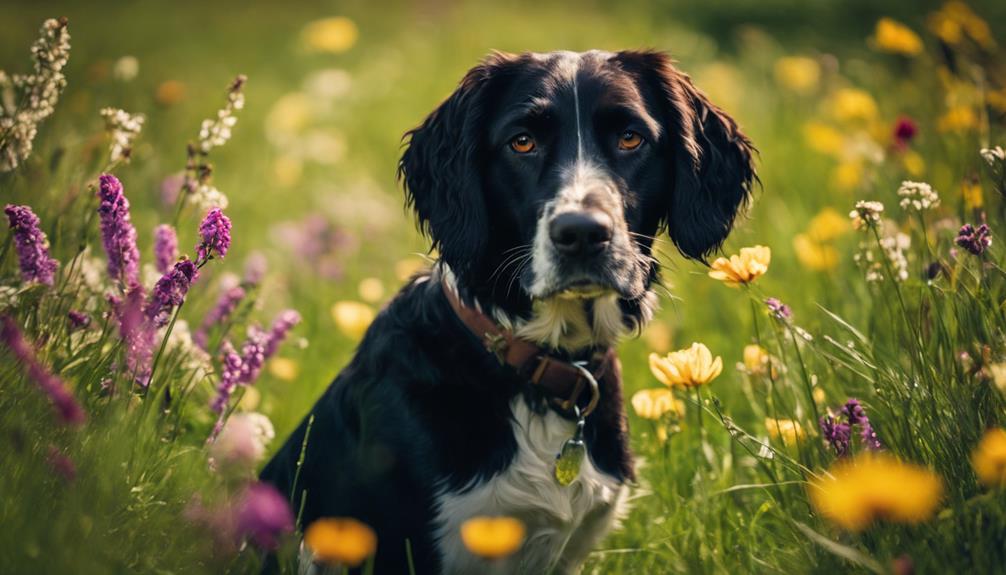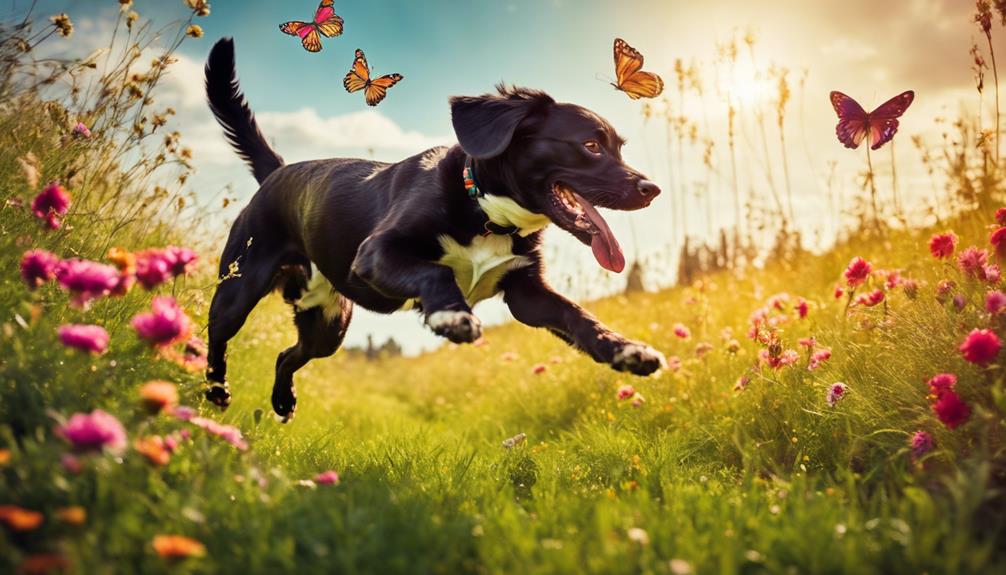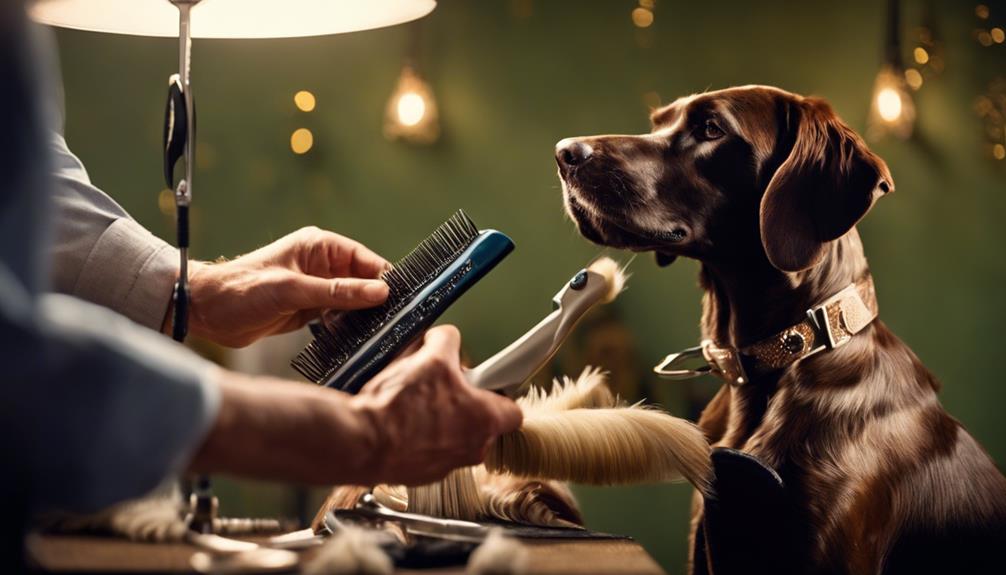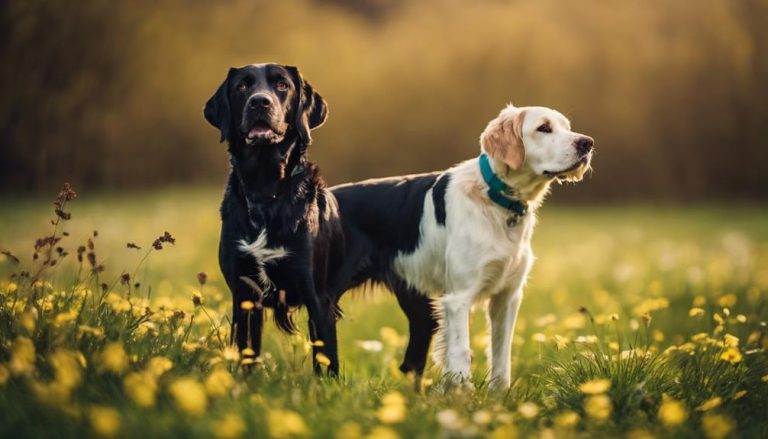Springador: The Perfect Family Companion
The Springador is a mix between Labrador Retrievers and English Springer Spaniels. This breed is known for its loyalty and high energy levels, requiring daily exercise and activities to keep them mentally and physically fit. It’s vital for their health to have preventive measures in place, such as health screenings for common genetic issues like hip and elbow dysplasia, ear infections, and Progressive Retinal Atrophy (PRA). A proper grooming routine, a nutritious diet, and early socialization are key to their care. These steps help in raising a well-behaved pet.
Taking care of a Springador also means paying attention to their grooming needs, ensuring they eat well, and socializing them from a young age. Training them well and keeping them engaged prevents behavioral issues. This breed thrives on companionship and activities that stimulate their mind and body. With the right care and attention, Springadors make great lifelong companions.
Key Takeaways
- Springadors combine Labradors and English Springer Spaniels.
- They need daily exercise for health and happiness.
- Prone to hip dysplasia and ear issues, vet visits are key.
Quick Facts
Springadors are a lively mix of Labrador Retrievers and English Springer Spaniels, combining traits like friendliness, agility, and a keen sense for hunting. They typically weigh between 30-50 pounds and are known for their boundless energy and sociable nature. These dogs inherit the best from both worlds: the Labrador’s eagerness to please and trainability with the Springer’s athleticism and instinct for the hunt. As a result, they make ideal companions for active families who can keep up with their high exercise needs.
These dogs require daily physical activity and mental stimulation to stay happy and well-behaved. Without enough to do, they might develop behavioral problems due to boredom or lack of stimulation. Owners should also pay attention to the health risks common to both parent breeds, making regular vet visits and preventative care a priority. In short, Springadors are perfect for energetic individuals or families ready to invest time in their dog’s physical and mental well-being.
Overview

Springadors are a hybrid breed that combines the best traits of Labrador Retrievers and English Springer Spaniels, making them energetic, smart, and friendly. These dogs are the perfect fit for people who love an active and intelligent companion. They usually weigh between 30-50lbs and have a medium, athletic build that suits various activities. This makes it crucial for them to get regular exercise to stay healthy and happy.
Exercise and mental stimulation are key for Springadors, as they thrive on being active and engaged. Activities that keep them moving and thinking help prevent boredom and ensure their development is well-rounded. Owners looking to bring a Springador into their family should check the health of both parent breeds. This helps avoid any hereditary health issues and ensures the puppies are as healthy as possible.
Choosing a Springador means committing to their care, especially in keeping them physically and mentally stimulated. Their blend of traits from Labrador Retrievers and English Springer Spaniels makes them not just pets but companions for life.
Lab-Spaniel Mix Overview
This section dives deeper into the Lab-Spaniel mix, also known as Springadors. These dogs are a cross between Labrador Retrievers and English Springer Spaniels, combining traits from both breeds that make them exceptionally friendly and full of energy.
Labrador Retrievers are known for their friendly and sociable nature, with a typical weight range of 55-80lbs. English Springer Spaniels, on the other hand, are energetic and sociable, weighing in at around 40-50lbs. These characteristics come together in Springadors, which usually weigh between 30-50lbs. They display a sociable personality paired with high energy levels, making them a great fit for active families.
Training Springadors with positive reinforcement is crucial, especially due to their Springer Spaniel ancestors’ hunting instincts. Owners should also be aware of health issues common to both parent breeds and ensure that health tests are done on the parent dogs. Springadors need regular exercise, socialization, and companionship to thrive, emphasizing the need for a lively and caring home environment.
Breed Origin Summary

The Springador breed is a creative mix of Labrador Retriever and English Springer Spaniel. This mix was intentionally created to combine the best traits of both breeds into a dog that excels in intelligence, energy, and versatility. The merging of these two breeds was done with the goal of producing a dog that is not only smart but also highly adaptable to various working environments.
Springador Genetic Background and Breed Evolution were carefully considered during its development. The idea was to take the Labrador Retriever’s well-known friendliness and ability to work closely with humans and blend it with the English Springer Spaniel’s agility and hunting skills. This combination aimed to produce a dog that could thrive in a variety of tasks, making the Springador an excellent choice for those in need of a capable and energetic companion.
Understanding the Influential Breeds behind the Springador is crucial for appreciating its unique characteristics. The Labrador Retriever brings a gentle, trainable nature to the mix, making the Springador an excellent family pet. On the other hand, the English Springer Spaniel contributes a lively and resilient spirit, enhancing the breed’s suitability for active lifestyles. Together, these influences result in a dog that is not only loving and loyal but also ready to tackle any challenge with enthusiasm.
Springador Genetic Roots
Springadors are a unique mix of two popular dog breeds, the Labrador Retriever and the English Springer Spaniel. Their genetic makeup combines the best traits of both, resulting in a dog that’s both friendly and high-spirited. Labradors are well-loved for their gentle and outgoing nature, traits that they pass down to their Springador offspring. This makes them great family pets.
On the other hand, the English Springer Spaniel brings a lively and sometimes challenging personality to the mix. This means Springadors need consistent training and socializing from a young age. They might also inherit the Springer Spaniel’s hunting instincts, making it important to teach them how to behave off-leash. Early and consistent training is key to making sure a Springador grows up to be well-behaved.
History and Development
Exploring the origins of the Springador breed uncovers a heritage rich in hunting and retrieving skills, thanks to its parents, the English Springer Spaniel and the Labrador Retriever.
The English Springer Spaniel, with roots in 16th-century England, was developed to hunt small game birds and mammals. Meanwhile, the Labrador Retriever, originally from Newfoundland, Canada, became known for its ability to retrieve waterfowl.
Both parent breeds have a long history of being valued for their hunting and retrieving abilities. This history paved the way for the creation of the Springador, a mix that combines the best traits of its ancestors.
The Springador is celebrated for its hunting, retrieving, and companionship qualities, showing the success of centuries of breeding for specific abilities.
Prominent Breed Influences
The Springador breed is a unique mix of two skilled hunters: the English Springer Spaniel and the Labrador Retriever. Originating from 16th century England, the English Springer Spaniel excels at flushing out small game thanks to its agility and sharp senses.
On the other hand, Labrador Retrievers, which started in Newfoundland, Canada, are known for their exceptional ability to retrieve waterfowl, thanks to their strong swimming skills.
This combination gives the Springador an edge in both land and water hunting activities. It merges the English Springer Spaniel’s knack for tracking with the Labrador Retriever’s retrieving talent. This makes the Springador a versatile dog, capable of performing a wide range of hunting and retrieving tasks. It’s this blend of abilities that highlights the rich heritage of the breed.
Medium-sized Hybrid

Springadors, a dynamic mix of Labrador Retriever and English Springer Spaniel, are the perfect companions for those looking for a pet that balances energy with affection. These dogs fall into a comfortable weight range of 30-50lbs, showcasing their adaptable size for various living environments.
Their personality is nothing short of vibrant, combining the friendly and outgoing nature of Labradors with the playful and energetic spirit of English Springer Spaniels. This makes them great family pets that thrive on interaction and bonding. However, their lively disposition means they require a good amount of exercise to keep them happy and healthy. Daily walks, runs, and mental challenges are essential to meet their physical and cognitive needs.
Understanding these characteristics is important for anyone considering a Springador as a pet. Their blend of traits demands commitment but promises a rewarding relationship filled with fun and companionship.
Ideal Weight Range
The ideal weight for Springadors, which are a blend of medium-sized dogs, is between 30-50lbs. This range depends on things like how old they are, their sex, what they eat, and how much they move. Keeping a Springador within this weight range is crucial for their health, as being too heavy or too light can lead to problems.
To keep a Springador healthy, owners need to pay close attention to their pet’s weight. This means regularly checking their weight, and adjusting their diet and exercise routines if necessary. A plan that’s specific to each dog’s needs is essential, taking into account their unique factors like age.
Temperament Traits
Springadors, a mix of Labrador Retrievers and English Springer Spaniels, are known for being both friendly and full of energy. This makes them great pets for families who love to be active. Being medium-sized dogs, they are known for their kind, playful, and loving nature. These traits come from their parent breeds.
They are smart and learn quickly, making training them a smooth process, especially if you use positive reinforcement. It’s important for their health and mood to get enough exercise every day. Springadors love being around people, getting along well with kids and other pets in the house. Starting their socialization early and keeping it consistent is key to helping them grow into well-behaved members of the family.
Exercise Requirements
Springadors, a lively mix of Labrador Retrievers and English Springer Spaniels, need a variety of exercise to stay happy and healthy. They require between 30 minutes and 2 hours of activity every day. Given their high energy, it’s crucial they get enough physical activity and mental challenges. Taking them for runs, swims, hikes, or playing interactive games can help meet their needs.
Keeping up with their exercise regime helps prevent behavioral problems and ensures their well-being. Proper exercise not only keeps them fit but also plays a key role in helping them reach their potential lifespan of 10-14 years. It’s essential for their overall health and happiness.
Grooming Needs
Taking care of a Springador’s coat requires a bit of effort. They are a medium-sized mix breed known for their love of play and need for moderate grooming. Brushing them regularly helps avoid knots and tangles in their fur. Since their coat is resistant to water, they don’t need baths too often, just enough to keep them clean and their skin healthy.
It’s crucial to clean their ears regularly because their floppy ears can trap moisture and lead to infections. Trimming their nails is necessary to prevent discomfort during their daily activities. Seasonal shedding also means you’ll need to up your grooming game a few times a year to handle the extra hair.
This routine not only keeps your Springador looking good but also supports their overall health. Remember, a little care goes a long way in ensuring your dog’s happiness and wellbeing.
Health Considerations
Due to their mixed heritage, Springadors might face some health challenges such as hip dysplasia, ear infections, and Progressive Retinal Atrophy (PRA), which they inherit from their Labrador Retriever and English Springer Spaniel parents. It’s crucial to screen the parents for these conditions to lower the risk for the puppies. Regular visits to the vet are key for catching and managing these issues early.
Keeping a balanced diet is also important. It helps in managing the dog’s weight, which is crucial for preventing hip dysplasia by lessening the pressure on their joints. Considering the risk of inherited conditions and the unpredictability in mixed-breed litters, getting pet health insurance is a smart move, especially if the parents haven’t been screened for health issues.
Affectionate and Energetic

The Springador dog breed is a perfect mix of love and vitality, making them ideal companions for both families and individuals who enjoy active lifestyles. Here’s what you need to know if you’re considering bringing a Springador into your home:
Springadors are incredible family pets because they form deep connections and offer constant friendship, which is great for families who appreciate pets that are both interactive and affectionate. They have plenty of energy, so it’s crucial to ensure they get enough exercise every day. This not only keeps them physically fit but also keeps their minds sharp.
Encouraging them to play and interact with others is key. This not only uses up some of their boundless energy but also helps them develop a friendly and balanced personality. For Springador dogs to thrive and for your home to remain peaceful, understanding and meeting their needs is vital.
Loving Family Companion
Springadors are the perfect example of what it means to be a loving family companion. They are known for their deep affection, unwavering loyalty, and boundless energy. These dogs love their families wholeheartedly, always showing their devotion. They need plenty of exercise and playtime to stay happy and healthy. Being part of family activities is something they enjoy, often wanting to be at the heart of everything going on at home.
Their playful nature makes them great at interactive games, helping them bond with family members. Springadors are also very friendly and get along well with kids and other pets. This makes them not just pets, but true members of the family, contributing to a happy and lively home environment.
High Energy Levels
Springadors are known for their high energy levels, which means they need a good amount of exercise every day to stay happy and healthy. They should be active for anywhere from 30 minutes to 2 hours daily. It’s not just about keeping them physically fit; these dogs need to use their brains too. Activities that make them think, like agility training or solving puzzles with special toys, are great for their mental health.
If Springadors don’t get enough physical and mental activity, they might start showing behaviors you won’t appreciate. This is simply because they have so much energy and nowhere to channel it. That’s why combining exercise and brain games is key. It not only keeps them in shape but also sharpens their minds.
For owners who love being active, Springadors are a perfect match. They thrive in environments where they can run, play, and learn new things, keeping both their bodies and minds engaged.
Playful Interactions
Springadors, a lively mix of Labrador Retriever and English Springer Spaniel, thrive in an environment filled with playful activities that match their affectionate and energetic nature. These dogs are naturally social, forming strong bonds with their human families.
They love engaging in fun activities like fetch, running, and discovering new places, which keeps them both physically and mentally sharp. Training sessions that challenge their minds and agility also help strengthen the bond with their owners, making sure they’re both happy and intellectually satisfied.
This approach highlights the need for a balance between loving interaction and active play in their daily lives.
Daily Exercise Needs
Springadors, a mix of Labrador and Springer Spaniel, are high-energy dogs that need 30 minutes to 2 hours of exercise every day to stay healthy and happy. They thrive on a variety of activities such as running, swimming, and hiking.
Regular exercise keeps them from getting bored, which can lead to behavior problems. It’s vital for Springadors to have an active lifestyle to maintain their well-being and ensure a peaceful household.
Making sure your Springador gets enough physical activity is key to their health and your happiness together.
Socialization Importance
Springadors need to stay physically active, but getting them to socialize is just as critical for their mental and emotional well-being. Socializing your Springador helps them learn how to interact properly with people and other pets, thanks to their friendly nature. This training is key to preventing bad habits and ensuring they’re approachable and pleasant to be around. For these lively dogs, mixing with others is a great way to use up their energy in a positive way, which helps stop them from getting bored and acting out.
Introducing your Springador to different situations and environments boosts their confidence and makes them more adaptable. A dog that’s good at socializing will show better behavior, be more open to making friends, and strengthen their bond with you, reflecting the breed’s inherently lovable and vibrant personality.
Common Health Concerns

The health of Springador dogs is shaped by genetics, how they live, and the care they receive. Addressing these factors is key to ensuring their health and longevity.
It’s essential to be aware of the genetic health risks that can affect Springadors. Knowing these can help in taking the right steps to prevent them. Preventive care practices are also crucial. Regular vet check-ups, vaccinations, and a healthy diet can significantly reduce health risks.
Springadors might face common diseases that are typical for their breed. Awareness and early detection are vital in managing these health issues effectively.
Caring for Springador dogs means understanding their unique needs. By focusing on their genetic predispositions, maintaining preventive care, and being alert to common diseases, you can help ensure a healthy, happy life for your pet.
Genetic Health Risks
Springador dogs, a mix known for their devotion and vibrant energy, are prone to particular health issues. These include hip dysplasia, ear infections, elbow dysplasia, and Progressive Retinal Atrophy (PRA).
Hip dysplasia involves a malformation of the hip joint, leading to potential arthritis and mobility problems. Their floppy ears make them susceptible to ear infections, which require careful management to avoid becoming recurrent issues. Elbow dysplasia impacts the elbow joints, similarly limiting a dog’s ability to be active.
Progressive Retinal Atrophy is an eye condition that slowly causes blindness. To ensure the health and happiness of Springador dogs, it’s crucial to test the health of their parents before breeding. Regular vet visits are also essential to keep an eye on and address these health concerns.
Preventive Care Tips
Taking your Springador for regular vet check-ups is key to catching and managing health issues like hip dysplasia, ear infections, and Progressive Retinal Atrophy early. These visits can spot problems before they become serious. It’s also vital to feed them a well-balanced diet. Proper nutrition helps with weight control and reduces the risk of obesity, which can make hip dysplasia worse.
Keeping your Springador active through exercise and mental challenges is another way to ensure they stay healthy and happy. These activities help keep their weight in check and prevent behavior problems, showing how important a comprehensive approach to their care is.
Common Diseases Identified
For owners of Springadors, it’s critical to be aware of common health issues like hip dysplasia, ear infections, elbow dysplasia, and Progressive Retinal Atrophy (PRA) to ensure their pets stay healthy. Hip dysplasia is a genetic issue where the hip joint doesn’t form properly, leading to arthritis and mobility problems. Regular check-ups with a vet can help manage this condition.
Elbow dysplasia, similar to hip dysplasia, affects the elbow joints and catching it early is key to preventing serious problems.
Ear infections can be a frequent problem, especially given the Springador’s floppy ears. Keeping their ears clean and dry is vital to prevent these infections from becoming a recurring issue.
Progressive Retinal Atrophy is a genetic condition that can cause blindness, so genetic testing and regular eye exams are important for early detection and management. To keep these conditions at bay, maintaining a healthy weight, providing a nutritious diet, and ensuring regular exercise are essential for a Springador’s wellbeing.
Grooming Needs

Caring for Springador dogs involves several grooming practices that are crucial for their health and comfort. These dogs require consistent brushing to handle their shedding and maintain a smooth coat.
It’s also vital to trim their nails regularly to avoid any pain or difficulty in moving.
Cleaning their ears properly is necessary to prevent infections and ensure they can hear well.
Keeping up with these grooming tasks ensures Springadors stay healthy and comfortable, showing the importance of a regular grooming schedule.
Coat Maintenance Tips
To keep a Springador’s coat looking its best, it’s crucial to brush it once a week. This routine helps avoid tangles and keeps their fur clean.
For a Springador’s unique coat, certain grooming tools come highly recommended. A slicker brush is great for working out knots and ridding the coat of loose hair, while a comb can tackle finer grooming tasks, ensuring the coat stays sleek and free of dirt.
During the shedding seasons, a shedding blade can be a lifesaver, helping to clear away dead hair and minimize fur buildup around the house.
Regular grooming, including nail trimming, ear cleaning, and dental care, plays a big part in a Springador’s health and happiness.
Brushing Frequency Advice
For a Springador’s coat to stay healthy and look good, it’s critical to brush it once a week. This helps to prevent tangles and keeps shedding under control. Brushing not only keeps their coat looking neat, but it also removes dead hair, which means less hair around your house. When it’s shedding season, you might need to brush your dog more often to handle the extra hair.
Keeping up with grooming isn’t just about making your Springador look nice. It’s also about their health and comfort. Regular brushing is a key part of taking care of your dog, making sure they’re not just good-looking but also happy and healthy.
Nail Care Essentials
Keeping your Springador’s nails trimmed is key to their health and comfort. Trimming every 2-4 weeks helps avoid issues like overgrowth and splitting, which can lead to pain during walks and affect their posture and movement.
It’s crucial to be careful not to cut too close to the quick, the sensitive part of the nail, to avoid bleeding. If you’re not confident in doing this yourself, it’s a good idea to have a professional groomer take care of it. This ensures your Springador’s nails are kept in good shape, supporting their mobility and overall well-being.
Bathing Routine Recommendations
Caring for your Springador’s nails is crucial for their health and mobility. It’s just as important to keep up with their bathing routine to ensure their coat and skin stay healthy.
Wash your Springador about every six to eight weeks for optimal cleanliness. It’s critical to use a shampoo made for dogs to maintain their coat’s natural oils and avoid irritating their skin. Regular washes help control shedding and keep their coat in good shape. Make sure to dry their coat well after a bath to prevent any skin problems or discomfort.
In addition to keeping them clean, bath time is a great opportunity to check your dog’s ears and trim their nails, keeping up with their overall grooming needs.
Ear Cleaning Practices
To ensure your Springador’s ear health, keeping up with their ear care is essential, given their floppy ears are more prone to infections. Creating a cleaning schedule with a vet-approved solution and cotton balls for the outer ear helps prevent problems. It’s crucial not to use cotton swabs inside their ears to avoid harm.
Watch out for redness, bad smell, or too much wax, as these are signs they need a clean. While the cleaning frequency can vary, doing it weekly or following your vet’s advice is a good rule of thumb to keep your Springador’s ears in top condition.
Dietary Requirements

Understanding the dietary needs of Springador dogs is essential for their health and vitality. It’s crucial to know what nutrients they require, how to avoid foods that could cause allergic reactions, and how often they should eat.
A focus on the nutritional needs of Springadors shows they need plenty of proteins and carbohydrates. This is because they are very active dogs. Avoiding food allergies is also key. Some ingredients can cause bad reactions, so it’s important to know what these are and keep them out of your dog’s diet.
Creating a feeding schedule helps maintain your dog’s metabolism and prevents overeating. This planned approach ensures that Springadors get a well-balanced diet that supports their energy and health.
This method of caring for your Springador’s diet helps them stay healthy and full of energy.
Nutritional Needs Overview
Springadors, being a mix of Springer Spaniel and Labrador, thrive on a diet packed with proteins and complex carbohydrates. These nutrients are vital for their energy and health, supporting their playful and active nature. Proteins help in building and repairing muscles, which is crucial given their love for running and playing. On the other hand, complex carbohydrates keep them energized throughout their day.
It’s important to adjust their food intake based on their age, size, and how active they are to avoid any health issues related to over or underfeeding. Feeding them two to three well-balanced meals daily is ideal for their digestive health and ensures they’re getting all the nutrients they need. Regular visits to the vet can help make sure their diet is on track and supports their well-being and energy, helping them live a full life of 10-14 years.
Common Food Allergies
Springadors may have allergies to foods like grains, soy, dairy, and certain proteins because of their genetics. These allergies can cause problems such as itching, stomach issues, ear infections, and skin conditions.
If a Springador shows these symptoms, switching to a hypoallergenic or limited ingredient diet could really help. This kind of diet helps find out which foods are causing problems and stops them from being fed to the dog.
It’s also really important to talk to a vet to figure out the best diet for a Springador with food allergies. With a vet’s advice, owners can make sure their pets get the right nutrition while avoiding allergic reactions.
Optimal Feeding Schedule
Creating the optimal feeding schedule for a Springador requires a deep understanding of their specific needs, which vary with their age, size, and how active they are. A high-quality diet rich in protein is crucial for these energetic dogs to thrive. Springador puppies, who are growing quickly, need to eat 3-4 times a day. On the other hand, adult Springadors do well with two meals a day to keep their energy up and maintain a healthy weight. The amount of food they need depends on the dog’s age, weight, activity level, and metabolism. Talking to a vet can help pinpoint the perfect feeding plan, ensuring your Springador gets a nutritious diet that keeps them healthy and full of life.
It’s important to adjust meal sizes appropriately for your dog’s specific conditions. Consulting with a veterinarian can provide valuable insights, helping you find a diet plan that promotes your Springador’s overall health and energy.
Frequently Asked Questions
Are Springadors Good Family Dogs?
- Springadors are sociable, fitting well in family settings.
- They love kids and thrive in active homes.
- Exercise is essential for their happiness and health.
Can Springadors Be Left Alone?
- Train dogs for solo time to curb separation anxiety.
- Use behavioral enrichment to keep them busy and calm.
- Seek anxiety solutions to support their independence.
Do Springador Dogs Shed?
- Springadors shed moderately, brush them often.
- Their coats reflect Labrador and Spaniel origins.
- Regular grooming keeps fur healthy and manageable.
Do Springadors Have Health Problems?
- Springadors may suffer from hip dysplasia.
- They can also face Progressive Retinal Atrophy risks.
- Regular vet checks and exercise are key for health.

